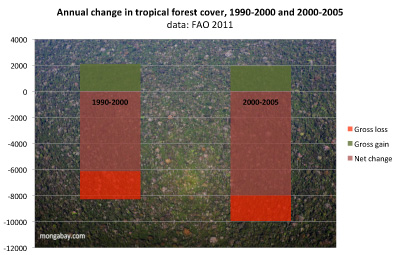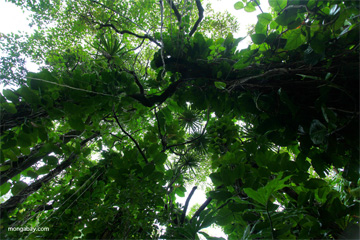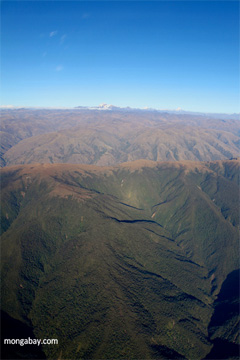
A program proposed to reduce greenhouse gas emissions from deforestation and degradation made mixed progress during climate talks in Durban. Significant questions remain about financing and safeguards to protect against abuse, say forestry experts.
REDD+ aims to reduce deforestation, forest degradation, and peatland destruction in tropical countries. Here, emissions from land use often exceed emissions from transportation and electricity generation. Under the program, industrialized nations would fund conservation projects and improved forest management.
While REDD+ offers the potential to simultaneously reduce emissions, conserve biodiversity, maintain other ecosystem services, and help alleviate rural poverty, concerns over potential adverse impacts have plagued the program since its conception.
|
|
In particular, some worry that REDD could exacerbate existing problems in the forestry sector in developing countries, including corruption and land disputes in places where traditional forest users often lack title. Others say REDD+ could create perverse incentives for converting low carbon landscapes into single-species plantations or even undermine efforts to develop clean energy technologies elsewhere if carbon credits generated from forest conservation activities reduce the overall price of carbon in the market or allow industrialized countries to offset emissions without cutting their own. Still others fear the effectiveness of REDD+ could be thwarted by dodgy accounting standards and the impact of climate change itself, which in some regions appears to be reducing forests’ ability to store carbon. Finally business-as-usual interests, as well as some forest users, are alarmed that REDD+ could limit their options when it comes to exploiting forests.
For these reasons, REDD+ has been the subject of intense discussions since it emerged from the climate conference in Bali, Indonesia in 2007. Supporters hoped talks in Durban this year would resolve some of the final outstanding issues, including financing, safeguards, reference levels for baselines in calculating emissions reductions, and monitoring, reporting and verifying (MRV) of carbon emissions from deforestation and forest degradation.
Efforts to address these issues proceeded on two tracks in Durban: the Long-term Cooperative Action (LCA) on financing and the Subsidiary Body for Scientific and Technological Advice (SBSTA) for everything else. Progress on both tracks was mixed.
Finance
|
|
On the finance front, negotiators punted final decisions to a later date, effectively leaving several funding options on the table for REDD+. That means the debate over whether REDD+ funding takes the form of bilateral aid, market-based carbon trading, or something in between will continue at least into 2012. However Andrew Hedges, a partner at the law firm Norton Rose LLP, told Reuters that the decision provided a positive signal to REDD project developers.
“For the private sector interested in long-term reputable investments associated with REDD+ actions, this is a very positive decision,” Hedges was quoted as saying. “It also recognizes that market-based approaches may be developed in coming years.”
Safeguards
Consensus was found on reference levels, enabling countries to propose baseline deforestation levels as a basis for REDD+ payments. Some environmentalists voiced concern that the system could allow countries to inflate projected deforestation levels in order to earn more cash, but the Environmental Defense Fund noted that should a country adjust its reference level, it will “have to justify each adjustment individually to the satisfaction of an expert review panel.”
“This is an important safeguard that will promote environmental integrity,” wrote Gus Silva-Chavez in an EDF blog post.
|
|
The REDD+ text also allows accounting of emissions from peatlands degradation, which is thought to account for up to 6 percent of global emissions even though peatlands are limited to only 0.5 percent of Earth’s surface. The inclusion of peatlands means that countries which rehabilitate peatlands could qualify for REDD+ payments, according to Wetlands International.
“This offers great opportunities for reducing the massive CO2 emissions from tropical peatswamp forests worldwide, in particular in Indonesia where peatland drainage and peat fires result in some 900 million tons of CO2 per year; more than the loss of forest vegetation,” said the group in a press release.
There was also agreement on safeguard reporting, although safeguards themselves were weakened. The REDD+ text requires forest countries to submit “qualitative information” on how safeguards were implemented, rather than more rigorous before-and-after data.
Louis Verchot, a climate change scientist at CIFOR, said the decision to limit safeguards was likely to make it easier for tropical countries to meet requirements to access REDD+ funds.
“The feeling among developing countries is that they need to start getting something out of the program and there needs to be fewer hoops to jump through before receiving the promised support,” he said, according to CIFOR’s blog.
But the watered-down safeguards were criticized by green groups.
“The safeguards are a crucial part of REDD+,” said Lars Løvold, Director of Rainforest Foundation Norway, in statement. “They are constructed to ensure that REDD+ not only avoids doing harm, but that it delivers wider social and environmental benefits like protecting indigenous peoples’ rights and biodiversity. The Durban decision is a step backwards from what countries agreed to in Cancun, as they failed to agree on a robust reporting system for how the safeguards are being implemented.”
“The provisions for safeguards in forest conservation are being shredded,” Raja Jarrah, a REDD expert at CARE, told Reuters. “This is bad news for millions of indigenous people and local communities whose livelihoods depend on forests.”
|
|
To the further dismay of some, the new text doesn’t specifically preclude conversion of natural landscapes for REDD+ projects or first-time logging of old-growth forests. Experiences with some projects certified under the Clean Development Mechanism (CDM) — which generates carbon credits for activities that reduce emissions — have made some environmentalists wary that REDD credits could finance industrial tree plantations in place of natural forests.
“Ending deforestation alone – by allowing primary old forests to be so heavily logged and destroyed they become plantations – won’t sustain biodiversity, ecosystems, local people, climate, a steady state economy, or the biosphere,” Glen Barry, an activist who runs Ecological Internet, told mongabay.com. “For continued ecological being, it is essential that we instead fully protect standing, large, connected and ecologically intact primary rainforests and other old forests, and restore old growth from regenerating natural forests.
But John O. Niles, Director of the Tropical Forest Group, said that while there have been problems in the past with Land Use, Land-Use Change and Forestry (LULUCF) projects and drawn-out discussions over REDD are intended to help avoid those pitfalls.
“After COPs, there are always some who say the world has ended; REDD+ will turn into a frenzy of GMO tree-planting that will evict all native people from their forests,” he told mongabay.com. “I don’t subscribe to this alarmist interpretation year in and year out. The reality is what we saw in Durban was international environmental democracy, negotiated by all countries, through consensus. And world governments made progress.”
Furthermore, there are efforts to link REDD finance to safeguards through standards now used in the voluntary carbon market. High quality REDD+ credits carry a premium and present fewer risks to investors.
“No institutional investor wants to buy carbon credits associated with social conflict or conversion of primary forests to monoculture plantations,” said one market participant who requested anonymity because he wasn’t authorized to speak on behalf of his firm. “The only REDD credits we are going to buy are going to have safeguards and represent real, measurable, permanent and independently verifiable reductions.”
Niles added that although much work is left to be done, talks in Durban represented progress toward reducing greenhouse gas emissions.
“Broadly, the Durban Platform advanced hopes for an eventual deal where all major emitters come under one roof, albeit not now but in several years,” he said. “For REDD+, we see some of the strongest language on safeguards compared to other international agreements. And most important, we finally have the machinery in play to develop credible REDD+ reference levels. Was all this fast enough, strong enough, tough enough? I don’t think so. Are there going to be more fights on safeguards and reference levels and targets in coming years. Absolutely. But what happened in Durban at large and for REDD+ in particular, is significant forward progress. Any one who says otherwise was hoping for a unicorn. We got a rhino.”
Related articles



